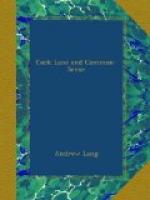Reginald Scot, the humane author who tried, in his Discovery of Witchcraft, 1584 (xv. 39), to laugh witch trials away, has a triumphant passage on the decline of superstition. ’Where are the soules that swarmed in time past? where are the spirits? who heareth their noises? who seeth their visions?’ He decides that the spirits who haunt places and houses, may have gone to Italy, because masses are dear in England. Scot, as an ardent Protestant, conceived that haunted houses were ‘a lewd invention,’ encouraged, if not originated, by the priests, in support of the doctrine of purgatory. As a matter of fact the belief in ‘haunting,’ dates from times of savagery, when we may say that every bush has its bogle. The Church had nothing to do with the rise of the belief, though, early in the Reformation, some ‘psychical phenomena’ were claimed as experimental proofs of the existence of purgatory. Reginald Scot decidedly made his Protestant boast too soon. After 300 years of ‘the Trewth,’ as Knox called it, the haunted houses are as much part of the popular creed as ever. Houses stand empty, and are said to be ‘haunted’. Here not the fact of haunting, but only the existence of the superstition is attested. Thus a house in Berkeley Square was long unoccupied, for reasons perfectly commonplace and intelligible. But the fact that it had no tenants needed to be explained, and was explained by a myth,—there were ghosts in the house! On the other hand, if Reginald Scot asked today, ’Who heareth the noises, who seeth the visions?’ we could answer, ’Protestant clergymen, officers in the army, ladies, land-agents, solicitors, representatives of all classes, except the Haunted House Committee of the Psychical Society’.
Before examining the researches and the results of this learned body, we may glance at some earlier industry of investigators. The common savage beliefs are too well known to need recapitulation, and have been treated by Mr. Tylor in his chapter on ‘Animism,’ {129} and by Mr. Herbert Spencer in Principles of Psychology. The points of difference between these authors need not detain us here. As a rule the spirits which haunt the bush, or the forest, are but vaguely conceived of by the Australian blacks, or Red Men: they may be ghosts of the dead, or they may be casual spirits unattached. An example analogous to European superstition is given by John Tanner in his Narrative of a Captivity among the Red Indians, 1830. In this case one man had slain his brother, or, at least, a man of his own Totem, and was himself put to death by the kindred. The spectres of both haunted a place which the Indians shunned, but Tanner (whose Totem was the same as that of the dead) passed a night on the scene. His dreams, if not his waking moments, for his account is indistinct, were disturbed by the ghosts. It is impossible to ascertain how far this particular superstition was coloured by European influences. {130}




